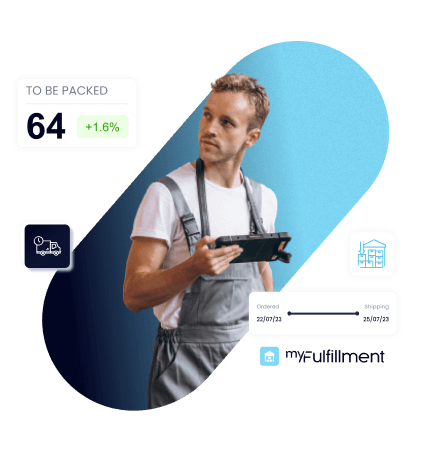Warehouse Management for E-commerce: The Complete 2025 Strategy Guide
Why Warehouse Management Matters More Than Ever in 2025
E-commerce has entered a new era—where speed, accuracy, and agility are no longer competitive advantages, but fundamental expectations. As online shopping continues to surge and brands expand across multiple sales channels, warehouse management has become the engine that keeps operations running smoothly.
1. Rising Customer Expectations
Today’s shoppers expect real-time stock visibility, next- or same-day shipping, and frictionless returns. A single delay or stock error can lead to lost sales and damaged brand loyalty.
2. Multichannel Complexity
Selling on multiple platforms—Shopify, Magento, PrestaShop, WooCommerce, BigCommerce, Adobe Commerce, and more—creates massive fulfillment complexity. Without centralized inventory and order management, businesses risk overselling, backorders, and slow dispatch times.
3. Global Expansion & Distributed Warehousing
As brands grow into international markets, they often manage multiple warehouses or 3PLs. Coordinating inventory across locations requires tight control and real-time visibility—something manual spreadsheets can’t handle.
4. Increased Cost Pressure
Rising labor and shipping costs mean there’s less room for inefficiency. Every mispick, delayed order, or inventory mismatch cuts directly into margins.
Core Components of a Winning Warehouse Strategy in 2025
To stay competitive in 2025, e-commerce businesses need a warehouse strategy that’s not just efficient—but intelligent, agile, and scalable. Here are the core components that define a future-ready warehouse operation:
1. Centralized Inventory Visibility
Real-time inventory data across all warehouse locations and sales channels is non-negotiable. Without it, stockouts, overselling, and order delays are inevitable.
What to implement:
- A centralized WMS (Warehouse Management System)
- Real-time synchronization with your CMS (Shopify, Magento, PrestaShop, WooCommerce, BigCommerce, Adobe Commerce)
With MyFulfillment, stock updates are instant and accurate—across all platforms.
2. Automated Order Management
Manual order processing is a bottleneck. Automation accelerates dispatch, reduces human error, and ensures consistent service.
What to implement:
- Smart picking methods (batch, wave, zone)
- Automated shipping label generation
- Rule-based order routing
MyFulfillment supports customizable workflows that scale with order volume.
3. Integrated Purchasing & Replenishment
Avoiding overstock and stockouts requires a tight integration between sales forecasts and purchasing actions.
What to implement:
- Reorder point alerts
- Demand-based restocking suggestions
- Supplier integration
MyFulfillment helps automate procurement based on real-time demand and lead times.
4. Flexible Warehouse Layouts & Smart Picking
As SKU count grows, optimizing picking paths and zones can save hours. A good layout boosts accuracy and reduces labor fatigue.
What to implement:
- Slotting strategies (based on frequency and size)
- Optimized picking routes
- Barcode scanning and mobile picking
MyFulfillment adapts to your physical space, supporting optimized picking logic and barcode workflows.
5. Returns Management
Returns are unavoidable. A streamlined process helps minimize loss and quickly restocks resaleable items.
What to implement:
- Return tracking
- Condition-based routing
- Automated refunds/restocking
MyFulfillment lets you process returns efficiently, with traceability at every step
Top Warehouse Challenges and How to Overcome Them in 2025
Even with the right intentions, many e-commerce operations face daily warehouse bottlenecks that hurt profitability and customer satisfaction. Here are the top challenges and how to solve them with a smarter approach:
Challenge 1: Lack of Real-Time Inventory Accuracy
The risk: Stockouts, overselling, delayed shipments.
The fix: Centralize inventory tracking across all channels with real-time updates.
How MyFulfillment helps: It keeps your inventory in sync across all CMS platforms (Shopify, Magento, PrestaShop, WooCommerce, BigCommerce, Adobe Commerce), eliminating the risk of selling unavailable stock.
Challenge 2: Manual & Error-Prone Order Fulfillment
The risk: Picking errors, slow fulfillment, high labor costs.
The fix: Automate the order lifecycle—from picking to shipping.
How MyFulfillment helps: It supports barcode scanning, smart picking routes, and automated label printing to reduce human error and accelerate dispatch.
Challenge 3: Inefficient Warehouse Layout and Workflows
The risk: Wasted time, misplaced items, bottlenecks during peak periods.
The fix: Use layout intelligence and task prioritization to improve throughput.
How MyFulfillment helps: It allows flexible configuration of picking zones, slotting strategies, and optimized picking paths to suit your space and team.
Challenge 4: Complex Multi-Channel Fulfillment
The risk: Order delays, miscommunication, poor customer experience.
The fix: Streamline workflows across all channels from one central system.
How MyFulfillment helps: It unifies order processing for webstores, marketplaces, and retail POS—so your team works smarter, not harder.
Challenge 5: Poor Visibility into KPIs and Warehouse Performance
The risk: Missed improvement opportunities and unscalable operations.
The fix: Leverage dashboards and reporting for real-time visibility.
How MyFulfillment helps: It offers performance tracking and actionable metrics across inventory, order processing, and warehouse activities.
Smart Tech & Automation Tools Defining 2025 Warehousing
To stay competitive in today’s D2C landscape, modern warehouses can’t afford to operate like it’s 2015. The most successful e-commerce brands are embracing automation and smart technology to increase speed, accuracy, and scalability—without expanding headcount.
Here’s what’s leading the charge in 2025:
1. Automated Order Picking Systems
Why it matters: Faster fulfillment, reduced human error, and better use of warehouse labor.
How it works: Barcode scanning, mobile devices, and guided workflows cut down on picking time.
With MyFulfillment: Your team gets step-by-step picking instructions based on real-time order data and optimized routes—right from a mobile device.
2. Smart Inventory Replenishment
Why it matters: Never run out of stock—or overstock again.
How it works: Predictive analytics flag low inventory and recommend reorder quantities based on real demand.
With MyFulfillment: It automates purchasing workflows, sets reorder rules, and helps you maintain optimal inventory levels.
3. Seamless CMS & Marketplace Integrations
Why it matters: Centralization avoids overselling, underselling, and delays across channels.
How it works: Inventory, orders, and tracking sync in real time with platforms like Shopify, Magento, PrestaShop, BigCommerce, WooCommerce, and Adobe Commerce.
With MyFulfillment: You get native, no-hassle integrations across your entire tech stack—including carriers and POS.
4. Live Dashboards & Warehouse Performance Analytics
Why it matters: Visibility into your operations helps spot inefficiencies and track team output.
How it works: Real-time dashboards show key KPIs like order volume, picking speed, and stock movement.
With MyFulfillment: Warehouse managers get a command center to monitor, report, and optimize daily activity—all in one place.
How to Build a Scalable Warehouse Strategy for 2025 and Beyond
Scaling your warehouse operations isn’t just about handling more orders—it’s about doing it efficiently, cost-effectively, and without compromising on customer experience. Here’s how leading e-commerce businesses are building fulfillment strategies that grow with them:
1. Start with Modular Systems
Why: Your needs will evolve. Your systems should too.
Tip: Avoid rigid software. Instead, choose modular solutions that adapt to changes in order volume, SKUs, or channel mix.
MyFulfillment is modular by design. Start with the essentials, then scale features—like purchasing automation or POS sync—when you’re ready.
2. Centralize Multi-Channel Operations
Why: Selling on 5 channels with 5 different workflows is a recipe for chaos.
Tip: Use a single platform to unify inventory, orders, and shipments across marketplaces, webshops, and physical stores.
MyFulfillment gives you one command center to manage all your channels—from Magento and PrestaShop to Shopify, WooCommerce, and beyond.
3. Optimize Your Warehouse Layout & Workflows
Why: Even the best software can’t overcome physical inefficiencies.
Tip: Analyze order data to reorganize zones, minimize walking paths, and streamline picking routes.
MyFulfillment’s data-driven insights help you improve warehouse design by showing you top-picked SKUs, movement patterns, and bottlenecks.
4. Use Data to Drive Forecasting & Purchasing
Why: Over-purchasing kills cash flow; under-purchasing kills sales.
Tip: Tap into historical and real-time sales data to forecast demand and automate purchasing decisions.
MyFulfillment automatically flags low stock, predicts demand, and can even auto-generate POs—so you always stay ahead.
5. Empower Teams with Better Tools
Why: A great WMS multiplies your team’s productivity.
Tip: Give staff intuitive tools that are easy to learn and quick to use—especially during peak season or when onboarding new hires.
MyFulfillment’s user-friendly interface and mobile-first design make training easy and ramp-up fast.



